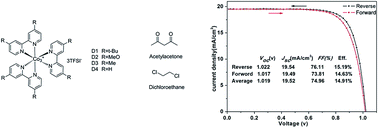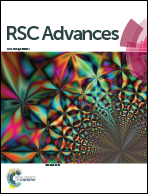Bipyridine type Co-complexes as hole-transporting material dopants in perovskite solar cells†
Abstract
Hole-transporting materials (HTM) have significant effects on solar cell properties and cobalt complexes are commonly used as dopants in the HTM layer. The molecular structure of the ligands always has an important influence on the capability of the dopant. In this work, a series of substituted bipyridine cobalt complexes were synthesized by modification of the molecular structure and were investigated as possible dopant alternatives. Their electron conductive ability and redox potentials were tested by characterizing their absorption spectroscopy and conductivity properties. The best dopant, based on tris(4,4′-di-tert-butyl-2,2′-dipyridyl)-cobalt(III) tris[bis(trifluoromethylsulfonyl)-imide], resulted in a power conversion efficiency of up to 14.91% measured under standard solar conditions (AM 1.5G, 100 mW cm−2). In addition, the co-solvent system of dichloroethane and acetylacetone was specifically selected for the bipyridine type dopants due to the greater solubility of both spiro and the dopant in this system. Because of the easy acquisition of the ligand and the simplicity of the synthesis of the complexes, this dopant represents a practical alternative as an efficient dopant for hole-transporting materials in perovskite solar cells.


 Please wait while we load your content...
Please wait while we load your content...